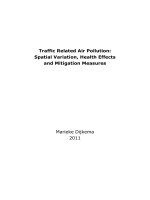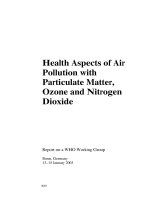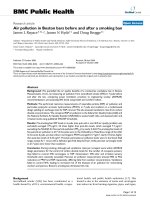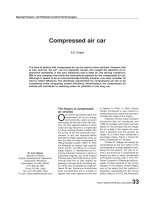Air Pollution Control Systems for Boiler and Incinerators.Unique control problems_7 doc
Bạn đang xem bản rút gọn của tài liệu. Xem và tải ngay bản đầy đủ của tài liệu tại đây (223.35 KB, 13 trang )
TM 5-815-1/AFR 19-6
10-5
Simpo PDF Merge and Split Unregistered Version -
TM 5-815-1/AFR 19-6
10-6
with a solution of sodium carbonate or sodium hydrox- scrubber under controlled reactor conditions.
ide to produce a solution of dissolved sodium sulfur The principal advantages of the dual alkali
salts. The solution is then oxidized to produce a neutral system are:
solution of sodium sulfate. Because it is a throwaway (a) Scaling problems associated with direct
process, the cost of chemicals make it an unattractive calcium-based scrubbing processes are
SO removal process when burning high sulfur fuels significantly reduced.
x
(greater than 1 percent). (b) A less expensive calcium base can be
t. Dual alkali sodium scrubbing. used.
(1) The dual alkali SO removal system is a (c) Due to high solubility and concentration
X
regenerative process designed for disposal of of active chemicals, lower liquid volumes
wastes in a solid/slurry form. As shown in can be used thereby lowering equipment
figure 10-6, the process consists of three costs.
basic steps; gas scrubbing, a reactor system, (d) Slurries are eliminated from the
and solids dewatering. The scrubbing system absorption loop, thereby reducing
utilizes a sodium hydroxide and sodium plugging and erosion problems.
sulfite solution. Upon absorption of SO in (e) A sludge waste, rather than a liquid waste,
2
the scrubber, a solution of sodium bisulfite is produced for disposal.
and sodium sulfite is produced. The scrubber (f) High SO removal efficiency (90% or
effluent containing the dissolved sodium salts more).
is reacted outside the scrubber with lime or u. Absorption of SO .
limestone to produce a precipitate of calcium (1) Activated carbon has been used as an absor-
salts containing calcium sulfate. The bent for flue-gas desulfurization. Activated
precipitate slurry from the reactor system is carbon affects a catalytic oxidation of 502 to
dewatered and the solids are deposed of in a SO , the latter having a critical temperature of
landfill. The liquid fraction containing 425 degrees Fahrenheit. This allows absorp-
soluable salts is recirculated to the absorber. tion to take place at operating temperatures.
Double alkali systems can achieve efficiencies The carbon is subsequently regenerated in a
of 90 - 95% and close to 100% reagent separate reactor to yield a waste which is used
utilization. in the production of high grade sulfuric acid,
(2) This system is designed to overcome the and the regenerated absorbent. There are
inherent difficulties of direct calcium slurry serious problems involved in the regeneration
scrubbing. All precipitation occurs outside the of the absorbent, including carbon losses due
2
2
3
Simpo PDF Merge and Split Unregistered Version -
TM 5-815-1/AFR 19-6
10-7
to attrition, chemical decomposition, serious subsequently store it as a sulphate in the pores
corrosion problems, and danger of of the zeolite.
combustion of the reactivated carbon. v. Cost of flue-gas desulfurization. The actual
(2) Zeolites are a class of highly structured alumi- capital and operating costs for any specific installation
num silicate compounds. Because of the reg- are a function of a number of factors quite specific to
ular pore size of zeolites, molecules of less the plant and include:
than a certain critical size may be — Plant size, age, configuration, and locations,
incorporated into the structure, while those — Sulfur content of the fuel and emission
greater are excluded. It is often possible to control requirements,
specify a certain zeolite for the separation of — Local construction costs, plant labor costs,
a particular material. Zeolites possesses and cost for chemicals, water, waste disposal,
properties of attrition resistance, temperature etc.,
stability, inertness to regeneration techniques, — Type of FGD system and required equipment,
and uniform pore size which make them ideal — Whether simultaneous particulate emission
absorbents. However, they lack the ability to reduction is required.
catalyze the oxidation of SO to SO and thus
2 3
cannot desulfurize flue-gases at normal
operating temperatures. Promising research is a. Efficiency requirement. The SO removal effi-
under way on the development of a zeolite ciency necessary for any given installation is dependent
material that will absorb SO at flue-gas upon the strictest regulation governing that installation.
2
temperatures by oxidation of SO and Given a certain required efficiency, a choice can be
3
10-3. Procedure to minimize SO emission
X
x
Simpo PDF Merge and Split Unregistered Version -
TM 5-815-1/AFR 19-6
10-8
Simpo PDF Merge and Split Unregistered Version -
TM 5-815-1/AFR 19-6
10-9
made among the different reduction techniques. This (3) Local market demand for recovered sulfur,
section shows how a rational basis can be utilized to (4) Plant design limitations and site charac-
determine the best method. teristics,
b. Boiler modification. This technique is useful in (5) Local cost and availability of chemicals, util-
reducing SO emissions by 0 to 6% depending upon ities, fuels, etc.,
x
the boiler. For industrial boilers operating above 20% (6) Added energy costs due to process pumps,
excess-air the use of proper control equipment or low reheaters, booster fans, etc.
excess-air combustion will usually reduce emissions by
4 to 5%. If the operating engineer is not familiar with 10-4. Sample problems.
boiler optimization methods, consultants should be uti-
lized.
c. Fuel substitution. This method can be used for
almost any percent reduction necessary. Availability
and cost of the fuel are the major factors to be consid-
ered. Fuels can be blended to produce the desired sul-
fur input. Care must be taken, however, so that the ash
produced by the blending does not adversely affect the
boiler by lowering the ash fusion temperature or caus-
ing increased fouling in the convection banks.
d. Flue-gas desulfurization. Various systems are
available for flue-gas desulfurization. Some of these
systems have demonstrated long term reliability of
operation with high SO removal efficiency. Lime/lime-
x
stone injection and scrubbing systems have been most
frequently used. It must be recognized that each boiler
control situation must be accommodated in the overall
system design if the most appropriate system is to be
installed. The selection and design of such a control
system should include the following considerations:
(1) Local SO and particulate emission require-
2
ments, both present and future,
(2) Local liquid and solid waste disposal regula-
tions,
The following problems have been provided to
illustrate how to determine the maximum fuel sulfur
content allowable to limit SO emission to any
particular level.
a. Approximately 90 to 97 percent of fuel sulfur is
oxidized to sulfur dioxide (SO ) during combustion.
2
This means that for every lb of sulfur in the fuel,
approximately 2 lbs of sulfur oxides will appear in the
stack gases. (The atomic weight of oxygen is ½ that of
sulfur.) Since most of the sulfur oxides are in the form
of SO , emissions regulations are defined in these units.
2
To estimate maximum probable SO emissions, the fol-
2
lowing equation applies:
b. Assume a fuel-oil burning boiler must limit emis-
sions to .35 lbs/MMBtu. What is the maximum allowa-
ble sulfur content if No.6 Residual fuel-oil is to be
used?
(1) From table 10-3, Typical Analysis of Fuel-Oil
Types, an average heating value of 18,300
Simpo PDF Merge and Split Unregistered Version -
TM 5-815-1/AFR 19-6
10-10
Btu/lb for No.6 residual fuel has been
assumed. Maximum allowable sulfur content
is determined as:
(2) Table 10-3 shows that No.5 and No.6 fuel
oils have fuel sulfur contents in excess of
.32%. If No.4 fuel oil is chosen, a fuel with
less than .32% sulfur may be available. e. Assume a coal burning boiler must limit SO
c. Assume a fuel-oil burning boiler must limit SO emissions to 1 lb/MMBtu. If sub-bituminous coal with
x
emission to .65 lbs/MMBtu. If No.6 residual fuel oil is a heating value of 12,000 to 12,500 Btu/lb (see table
to be used, can SO emission limits be met? 10-4) is to be used what is the maximum allowable
x
(1) From table 10-3, the minimum sulfur content fuel sulfur content?
in No.6 fuel oil is .7%. If .7% sulfur fuel can
be purchased, the heating value of the fuel
must be:
(2) Since the heating value of No. 6 fuel oil is able, what SO removal efficiency would be required
generally between 17,410 and 18,990 Btu/lb, burning 1% sulfur coal?
SO emission limits cannot be met using this
x
fuel. If we assume a No.6 fuel-oil with one
percent sulfur and a heating value of 18,600
Btu/lb is used the percent SO removal effi-
x
ciency that will be required is determined as:
d. Assume a boiler installation burns No.4 fuel-oil
with a heating value of 19,000 Btu/lb. What is the
maximum fuel sulfur content allowable to limit SO
x
emissions to .8 lbs/MMBtu?
x
f. Since coal of this low sulfur content is not avail-
x
Simpo PDF Merge and Split Unregistered Version -
TM 5-815-1/AFR 19-6
10-11
Simpo PDF Merge and Split Unregistered Version -
TM 5-815-1/AFR 19-6
10-12
Simpo PDF Merge and Split Unregistered Version -
TM 5-815-1/AFR 19-6
11-1
CHAPTER 11
NITROGEN OXIDES (NOx) CONTROL AND REDUCTION
TECHNIQUES
11-1. Formation of nitrogen oxides. tions produce more NO . The more bulk mixing of fuel
a. Nitrogen oxides (NO ). All fossil fuel burning
x
processes produce NO . The principle oxides formed
x
are nitric oxide (NO) which represents 90-95 percent
(%) of the NO formed and nitrogen dioxide (NO )
x 2
which represents most of the remaining nitrogen
oxides.
b. NO formation. Nitrogen oxides are formed pri-
x
marily in the high temperature zone of a furnace where
sufficient concentrations of nitrogen and oxygen are
present. Fuel nitrogen and nitrogen contained in the
combustion air both play a role in the formation of
NO . The largest percentage of NO formed is a result
x x
of the high temperature fixation reaction of
atmospheric nitrogen and oxygen in the primary
combustion zone.
c. NO concentration. The concentration of NO
x x
found in stack gas is dependent upon the time, tem-
perature, and concentration history of the combustion
gas as it moves through the furnace. NO concentration
x
will increase with temperature, the availability of oxy-
gen, and the time the oxygen and nitrogen simul-
taneously are exposed to peak flame temperatures.
11-2. Factors affecting NO emissions
x
a. Furnace design and firing type. The size and
design of boiler furnaces have a major effect on NO
x
emissions. As furnace size and heat release rates
increase, NO emissions increase. This results from a
x
lower furnace surface-to-volume ratio which leads to
a higher furnace temperature and less rapid terminal
quenching of the combustion process. Boilers generate
different amounts of NO according to the type of
x
firming. Units employing less rapid and intense burning
from incomplete mixing of fuel and combustion gases
generate lower levels of NO emissions. Tangentially
x
fired units generate the least NO because they operate
x
on low levels of excess air, and because bulk misting
and burning of the fuel takes place in a large portion of
the furnace. Since the entire furnace acts as a burner;
precise proportioning of fuel/air at each of the individ-
ual fuel admission points is not required. A large
amount of internal recirculation of bulk gas, coupled
with slower mixing of fuel and air, provides a combus-
tion system which is inherently low in NO production
x
for all fuel types.
b. Burner design and configuration. Burners oper-
ating under highly turbulent and intense flame condi-
x
and air in the primary combustion zone, the more tur-
bulence is created. Flame color is an index of flame
turbulence. Yellow hazy flames have low turbulence,
whereas, blue flames with good definition are consid-
ered highly turbulent.
c. Burner number. The number of burners and their
spacing are important in NO emission. Interaction
x
between closely spaced burners, especially in the center
of a multiple burner installation, increases flame
temperature at these locations. The tighter spacing
lowers the ability to radiate to cooling surfaces, and
greater is the tendency toward increased NO emis-
x
sions.
d. Excess air. A level of excess air greatly exceeding
the theoretical excess air requirement is the major
cause of high NO emissions in conventional boilers.
x
Negotiable quantities of thermally formed NO are
x
generated in fluidized bed boilers.
e. Combustion temperature. NO formation is
x
dependent upon peak combustion temperature, with
higher temperatures producing higher NO emissions.
x
f. Firing and quenching rates. A high heat release
rate (firing rate) is associated with higher peak tem-
peratures and increased NO emissions. A high rate of
x
thermal quenching, (the efficient removal of the heat
released in combustion) tends to lower peak tem-
peratures and contribute to reduced NO emissions.
x
g. Mass transportation and mixing. The con-
centration of nitrogen and oxygen in the combustion
zone affects NO formation. Any means of decreasing
x
the concentration such as dilution by exhaust gases,
slow diffusion of fuel and air; or alternate fuel-
rich/fuel- lean burner operation will reduce NO
x
formation. These methods are also effective in
reducing peak flame temperatures.
h. Fuel type. Fuel type affects NO formation both
x
through the theoretical flame temperature reached, and
through the rate of radiative heat transfer. For most
combustion installations, coal-fired furnaces have the
highest level of NO emissions and gas-fired
x
installations have the lowest levels of NO emissions.
x
i. Fuel nitrogen. The importance of chemically
bound fuel nitrogen in NO formation varies with the
x
temperature level of the combustion processes. Fuel
nitrogen is important at low temperature combustion,
but its contribution is nearly negligible as higher flame
temperatures are reached, because atmospheric nitro-
Simpo PDF Merge and Split Unregistered Version -
TM 5-815-1/AFR 19-6
11-2
gen contributes more to NO formation at higher tem-
x
peratures.
11-3. NO reduction techniques
x
a. Fuel selection. Reduction of NO emissions may
x
be accomplished by changing to a fuel which decreases
the combustion excess air requirements, peak flame
temperatures, and nitrogen content of the fuel. These
changes decrease the concentration of oxygen and
nitrogen in the flame envelope and the rate of the NO
x
formation reaction.
(1) The specific boiler manufacturer should be
consulted to determine if a fuel conversion
can be performed without adverse effects.
The general NO reduction capability of
x
initiating a change in fuel can be seen
comparatively in table 11-1.
(2) A consideration when comtemplating a
change in fuel type is that NO emission
x
regulations are usually based on fuel type.
Switching to a cleaner fuel may result in the
necessity of conforming to a more strict
emission standard.
(3) Changing from a higher to a lower NO
x
producing fuel is not usually an economical
method of reducing NO emissions because
x
additional fuel costs and equipment capital
costs will result. For additional information
on fuel substitution, see paragraph 10-3. In
doing so, it should be noted that changing
from coal to oil or gas firing is not in
accordance with present AR 420-49.
b. Load reduction. Load reduction is an effective
technique for reducing NO emissions. Load reduction
x
has the effect of decreasing the heat release rate and
reducing furnace temperature. A lowering of furnace
temperature decreases the rate of NO formation.
x
(1) NO reduction by load reduction is illustrated
x
in figure 11-1. As shown, a greater reduction
Simpo PDF Merge and Split Unregistered Version -
TM 5-815-1/AFR 19-6
11-3
in NO is attainable burning gas fuels because
2
they contain only a small amount of fuel-
bound nitrogen. Fuel-bound nitrogen
conversion does not appear to be affected by
furnace temperatures, which accounts for the
lower NO reductions obtained with coal and
x
oil firing. Some units such as tangentially
fired boilers show as much as 25 percent
decrease in NO emissions with a 25 percent
x
load reduction while burning pulverized coal.
(2) Although no capital costs are involved in load
reduction, it is sometimes undesirable to
reduce load because it may reduce steam
cycle efficiency.
c. Low excess air firing (LEA). In order to complete
the combustion of a fuel, a certain amount of excess air
is necessary beyond the stoichiometric requirements.
The more efficient the burners are in misting, the
smaller will be the excess air requirement. A minimum
amount of excess air is needed in any system to limit
the production of smoke or unburned combustibles;
but larger amounts may be needed to maintain steam
temperature to prevent refractory damage; to complete
combustion when air supply between burners is unbal-
anced; and to compensate for instrument lag between
operational changes. Practical minimums of excess air
are 7 percent for natural gas, 3 to 15 percent for oil
firing, and 18 to 25 percent for coal firing.
(1) Since an increase in the amount of oxygen
and nitrogen in a combustion process will
increase the formation and concentration of
NO , low excess air operation is the first and
x
most important technique that should be
utilized to reduce NO emissions. A 50
x
percent reduction in excess air can usualy
reduce NO emissions from 15 to 40 percent,
x
depending upon the level of excess air
normally applied. Average NO reductions
x
corresponding to a 50 percent reduction in
excess air for each of the three fuels in
different boiler types are shown in table 11-2.
Reductions in NO emission sup to 62 percent
x
have been reported on a pulverized coal fired
boiler when excess air is decreased from a
level of 22 percent to a level of 5 percent.
(2) The successful application of LEA firing to
any unit requires a combustion control system
to regulate and monitor the exact
proportioning of fuel and air. For pulverized
coal fired boilers, this may mean the
additional expense of installing uniform
distribution systems for the coal and air
mixture.
(3) Low excess air firing is a desirable method of
reducing NO emission because it can also
x
improve boiler efficiency by reducing the
amount of heat lost up the stack. Con-
sequently, a reduction in fuel combustion will
sometimes accompany LEA firing.
d. Low excess air firing with load reduction. NO
x
emissions may be reduced by implementing a load
reduction while operating under low excess air condi-
tions (table 11-2). This combined technique may be
desirable in an installation where NO emissions are
x
extremely high because of poor air distribution and the
resultant inefficient operation of combustible equip-
ment. A load reduction may permit more accurate con-
trol of the combustion equipment and allow reduction
of excess air requirements to a minimum value. NO
x
reduction achieved by simultaneous implementation of
load reduction and LEA firing is slightly less than the
combined estimated NO reduction achieved by sepa-
x
rate implementation.
e. Two-stage combustion. The application of delayed
fuel and air mixing in combustion boilers is referred to
as two stage combustion. Two-stage combustion can
be of two forms. Normally it entails operating burners
fuel-rich (supplying only 90 to 95 percent of
stoichiometric combustion air) at the burner throat, and
admitting the additional air needed to complete
combustion through ports (referred to as NO ports)
located above and below the burner. There are no ports
to direct streams of combustion air into the burner
flame further out from the burner wall thus allowing a
gradual burning of all fuel. Another form of two-stage
combustion is off-stoichiometric firing. This technique
involves firing some burners fuel-rich and others air-
rich (high percentage of excess air), or air only, and is
usually applied to boilers having three or more burner
levels. Off-stoichiometric firing is accomplished by
staggering the air-rich and fuel-rich burners in each of
the burner levels. Various burner configuration tests
have shown that it is generally more effective to
operate most of the elevated burners air-rich or air
only. Off-stoichiometric firing in pulverized coal fired
boilers usually consists of using the upper burners on
air only while operating the lower levels of burners
fuel-rich. This technique is called overfire air
operation.
(1) Two-stage combustion is effective in
reducing NO emissions because: it lowers
x
the concentration of oxygen and nitrogen in
the primary combustion zone by fuel-rich
firing; it lowers the attainable peak flame
temperature by allowing for gradual
Simpo PDF Merge and Split Unregistered Version -
TM 5-815-1/AFR 19-6
11-4
combustion of all the fuel; and it reduces the mixing accompanying the increased
amount of time the fuel and air mixture is combustion air/ gas volume. Gas recirculation
exposed to higher temperatures. does not significantly reduce plant thermal
(2) The application of some form of two stage efficiency but it can influence boiler
combustion implemented with overall low operation. Radiation heat transfer is reduced
excess air operation is presently the most in the furnace because of lower gas
effective method of reducing NO emissions temperatures, and convective beat transfer is
x
in utility boilers. Average NO reductions for increased because of greater gas flow.
x
this combustion modification technique in
utility boilers are listed in table 11-3.
However, it should be noted that this
technique is not usually adaptable to small
industrial boilers where only one level of
burners is provided.
f. Reduced preheat temperature. NO emissions are
x
influenced by the effective peak temperature of the
combustion process. Any modifications that lower
peak temperature will lower NO emissions. Lower air
x
preheat temperature has been demonstrated to be a
factor in controlling NO emissions. However, reduced
x
preheat temperature is not a practical approach to NO
x
reduction because air preheat can only be varied in a
narrow range without upsetting the thermal balance of
the boiler. Elimination of air preheat might be expected
to increase particulate emissions when burning coal or
oil. Preheated air is also a necessary part of the coal
pulverizer operation on coal fired units. Jn view of he
penalties of reduced boiler efficiency and other disad-
vantages, reduced preheat is not a preferred means of
lowering NO emissions.
x
g. Flue-gas recirculation. This technique is used to
lower primary combustion temperature by recirculating
part of the exhaust gases back into the boiler com-
bustion air manifold. This dilution not only decreases
peak combustion flame temperatures but also
decreases the concentration of oxygen available for
NO formation. NO reductions of 20 to 50 percent
x x
have been obtained on oil-fired utility boilers but as yet
have not been demonstrated on coal-fired units. It is
estimated that flue gas recirculation has a potential of
decreasing NO emissions by 40 percent in coal-fired
x
units.
(1) Flue gas recirculation has also produced a
reduction on CO concentrations from normal
operation because of increased fuel-air
(2) The extent of the applicability of this
modification remains to be investigated. The
quantity of gas necessary to achieve the
desired effect in different installations is
important and can influence the feasibility of
the application. Implementing flue-gas
recirculation means providing duct work and
recycle fans for diverting a portion of the
exhaust flue-gas back to the combustion air
windbox. It also requires enlarging the
windbox and adding control dampers and
instrumentation to automatically vary flue-gas
recirculation as required for operating
conditions and loads.
h. Steam or water injection. Steam and water injec-
tion has been used to decrease flame temperatures and
reduce NO emissions. Water injection is preferred
x
over steam because of its greater ability to reduce tem-
perature. In gas and coal fired units equipped with
standby oil firing with steam atomization, the atomizer
offers a simple means for injection. Other installations
require special equipment and a study to determine the
proper point and degree of atomization. The use of
water or steam injection may entail some undesirable
operating conditions, such as decreased efficiency and
increased corrosion. A NO reduction rate of up to 10
x
percent is possible before boiler efficiency is reduced
to uneconomic levels. If the use of water injection
requires installation of an injection pump and attendant
piping, it is usually not a cost-effective means of
reducing NO emissions.
x
11-4. Post combustion Systems for NO
x
reduction.
a. Selective catalytic reduction (SCR) of NO is
x
based on the preference of ammonia to react with NO,
rather than with other flue-gas constitutents. Ammonia
is injected so that it will mix with flue-gas between the
economizer and the air heater. Reaction then occurs as
this mix passes through a catalyst bed. Problems
requiring resolution include impact of ammonia on
downstream equipment, catalyst life, flue-gas
monitoring, ammonia availability, and spent-catalyst
disposal.
b. Selective noncatalytic reduction (SNR) Ammonia
is injected into the flue-gas duct where the temperature
favors the reaction of ammonia with NO in the flue-
x
gas. The narrow temperature band which favors the
reaction and the difficulty of controlling the tem-
perature are the main drawbacks of this method.
Simpo PDF Merge and Split Unregistered Version -
TM 5-815-1/AFR 19-6
11-5
c. Copper oxide is used as the acceptor for SO
2
removal, forming copper sulfate. Subsequently both
the copper sulfate which was formed and the copper
oxide catalyze the reduction of NO to nitrogen and
water by reaction with ammonia. A regeneration step
produces an SO rich steam which can be used to man-
2
ufacture by-products such as sulfuric acid.
11-5. Step-by-step NO reduction method
x
a. Applicability. The application of NO reduction
x
techniques in stationary combustion boilers is not
extensive. (However, NO reduction techniques have
x
been extensively applied on automobiles.) These tech-
niques have been confined to large industrial and utility
boilers where they can be more easily implemented
where NO emissions standards apply, and where
x
equipment modifications are more economically justi-
fied. However some form of NO control is available
x
for all fuel-burning boilers without sacrificing unit
output or operating efficiency. Such controls may
become more widespread as emission regulations are
broadened to include all fuel-burning boilers.
b. Implementation. The ability to implement a par-
ticular combustion modification technique is dependent
upon furnace design, size, and the degree of equipment
operational control. In many cases, the cost of con-
version to implement a modification such as flue-gas
recirculation may not be economically justified. There-
fore, the practical and economic aspects of boiler
design and operational modifications must be
ascertained before implementing a specific reduction
technique.
(1) Temperature reduction through the use of
two stage combustion and flue-gas
recirculation is most applicable to high heat
release boilers with a multiplicity of burners
such as utility and large industrial boilers.
(2) Low excess air operation (LEA) coupled with
flue-gas recirculation offers the most viable
solution in smaller industrial and commercial
size boilers. These units are normally
designed for lower heat rates (furnace
temperature) and generally operate on high
levels of excess air (30 to 60%).
c. Compliance. When it has been ascertained that
NO emissions must be reduced in order to comply
x
with state and federal codes, a specific program should
be designed to achieve the results desired. The
program direction should include:
— an estimate of the NO reduction desired,
x
— selection of the technique or combination
thereof, which will achieve this reduction;
— an economic evaluation of implementing each
technique, including equipment costs, and
changes in operational costs;
— required design changes to equipment
— the effects of each technique upon boiler
performance and operational safety.
d. Procedure. A technical program for implementing
a NO reduction program should proceed with the aid
x
of equipment manufacturers and personnel who have
had experience in implementing each of the NO
x
reduction techniques that may be required in the
following manner:
(1) NO emission test. A NO emission test
x x
should be performed during normal boiler
load times to ascertain actual on-site NO
x
generation. This test should include recording
of normal boiler parameters such as: flame
temperature; excess air; boiler loads; flue-gas
temperatures; and firing rate. These
parameters can be referred to as normal
operating parameters during subsequent
changes in operation.
(2) Reduction capabilities. The desired reduction
in NO emissions, in order to comply with
x
standards, should be estimated based on mea-
sured NO emission data. Specific NO re-
x x
duction techniques can then be selected based
on desired reductions and reduction capa-
bilities outlined in preceding paragraph 11-3.
(3) Equipment optimization. Any realistic pro-
gram for NO reduction should begin with an
x
evaluation and overhaul of all combustion
related equipment. A general improvement of
boiler thermal efficiency and combustion effi-
ciency will reduce the normal level of NO
x
emissions. Of major importance are:
(a) the cleanliness of all heat transfer surfaces
(especially those exposed to radiative heat
absorption),
(b) maintaining proper fuel preparation (siz-
ing, temperature, viscosity),
(c) insuring control and proper operation of
combustion equipment (burners nozzles,
air registers, fans, preheaters, etc.),
(d) maintaining equal distribution of fuel and
air to all burners.
(4) Low excess air operation. Low excess air
operation is the most recommended modific-
ation for reducing NO emission. Possible
x
reductions are given in preceding table 11-2.
How-ever, a control system is needed to
accurately monitor and correct air and fuel
flow in response to steam demands. Of the
control systems available, a system incorpo-
rating fuel and air metering with stack gas O
2
correction will provide the most accurate
control. A system of this nature will generally
pay for itself in fuel savings over a 2 to 3-year
period, and is economically justified on
industrial boilers rated as low as 40,000 lb of
steam/hr.
(5) Flue-gas recirculation. Flue-gas recirculation
is the second most effective NO reduction
x
technique for boilers where two stage
combustion cannot be applied. Low excess
Simpo PDF Merge and Split Unregistered Version -









